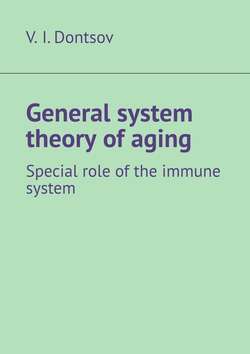Читать книгу General system theory of aging. Special role of the immune system - V. I. Dontsov - Страница 9
1.4. Features of the system approach as a modern universal scientific method of problem analysis
1.4.2. General methodology about the cause of phenomena
ОглавлениеWhen one speaks of a single natural theory of aging, it is quite clear that it must answer a number of central questions:
– the time of appearance of aging in evolution;
– whether aging is a general law of nature or a private mechanism for the existence of individual forms of the living;
– what are the essence and the fundamental, common cause of aging;
– what are the general laws and particular types and mechanisms of the manifestation of aging;
– what are the fundamental features of human aging;
– what are the general perspectives and ways to overcome aging as a natural phenomenon;
– what are the specific approaches to the effects on the main types and mechanisms of aging;
– the importance of aging in general, the general way to overcome it, and the peculiarities of this task in humans.
One of the central issues in the consideration of aging as a global phenomenon is the question of the primary cause and the deep, fundamental nature of aging.
Regarding the general methodology for the consideration of the issue, it should be said that it was known in ancient times – Platon developed it in the most complete form. The leading contemporary philosopher-methodologist A.F. Losev formulates the most important provisions for us as follows: “Current experience gives us an idea only of flowing and scattered bodies and events, in which neither beginning nor end is seen and whose meaning remains vague due to its fluidity, very often incomprehensible and blind… And since the scientific understanding of a thing requires the final disclosure of its meaning, then the theory of ideas arises as ultimately developed communities.”. A full-fledged scientific analysis is characterized as follows: “To understand and correct components is necessary through the whole… The idea is the ultimate community, has a structure and is meaningfully filled, respectively has it’s own specific (own) … already purely ideal objectivity and reality… this limiting community manifests itself in its particular, in a semantic way, never moving beyond its limits… The essence (of something) is interpreted as a principle of structure…”.
Thus, it is clear that the essence, the cause of aging can be expressed only in the language of high-level abstraction as an objective pattern of life, being, as a principle, but not at all as a process, much less as a specific special mechanism in the body. The reduction of principles to mechanisms is the main methodological error in the natural sciences, including in gerontology. It is quite clear that when defining the term “aging”, the definition of the principle of aging as a phenomenon turns out to be necessary and sufficient, which has been known and understood for a long time: aging is a decrease in viability with age, or an increase in the probability of death with time, or, more, in general terms, it can be said that aging is an increase in the degree of chaos at all structural levels of the organism, which is manifested by a general decrease in the body’s resistance to all factors and is recorded as an increase in the probability of death from all causes of aging.
The definition reveals the very essence of the phenomenon of aging, which acts as a global, fundamental cause of aging because the cause of the accumulation of chaos (entropy) in closed systems has long been known: it is a law of nature, known in particular as the second law of thermo-dynamics. Now the interpretation of this law has significantly expanded and deepened in connection with its extension to information processes.
In biology and mathematics, the most interesting are modern trends: theories of self-organization, theories of open systems, describing the generation of information, its relationship with chaos, the role of energy in this process, etc.
The applicability of the second law of thermodynamics to living systems is related to the fact that they are only partially open systems: in any modern complex organism, there are structures that are not updated inside the organism – cells, molecules, organelles, organs, etc. Thus, the fundamental reason for the aging of any complex systems is the discreteness of the forms of existence of modern organisms on Earth – separation from the external environment, which puts a limit on the capacity for the internal evolution of an organism while preserving its quality as a separate system. In general, this is known as the inevitability of the accumulation of chaos in any partially open system limited from the external environment with time.
The self-renewability of a living system within itself is not a sufficient factor in counteracting aging in general, since it is possible to counteract the second law of thermodynamics only due to external influences on the system and these influences essentially lead to evolution, and not to stabilize any system.
